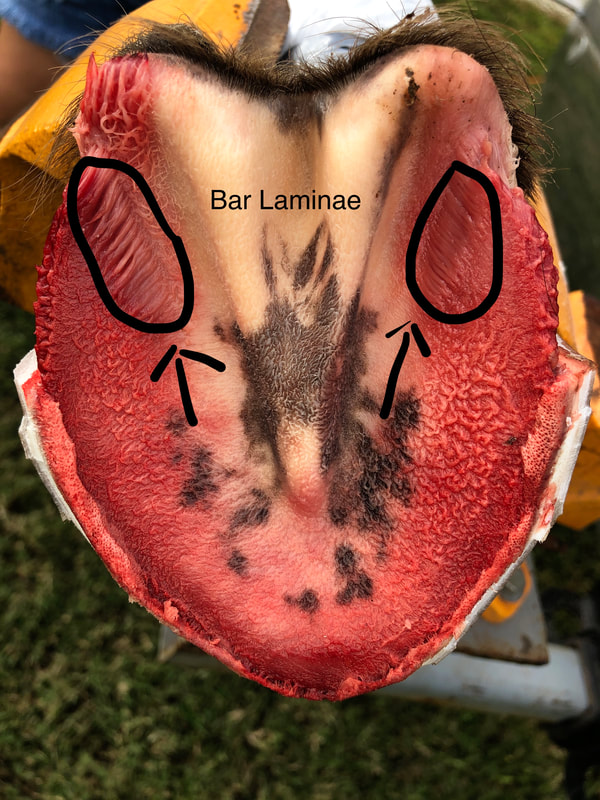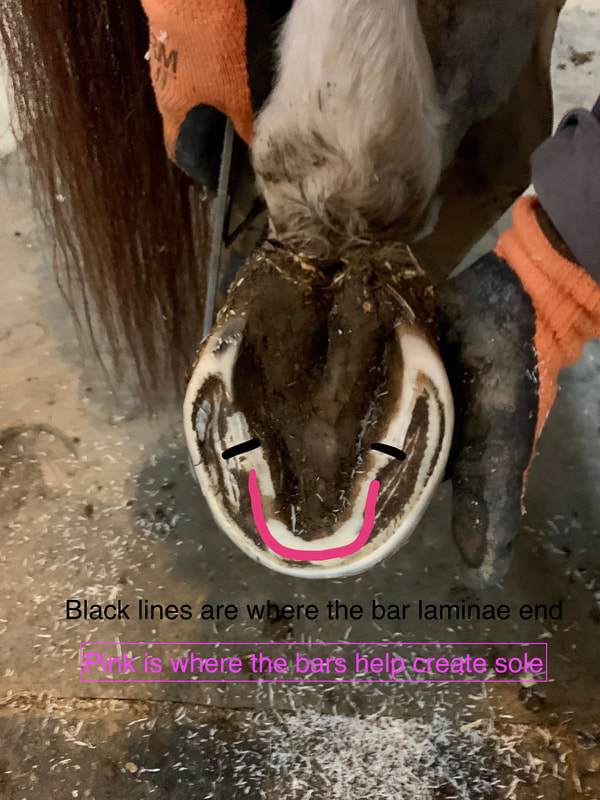Bars
This week’s hoof topic will be about bars. Out of all the parts of the horse’s hoof, the bars are probably the most controversial.
Some are of the mindset that the bars are the root of all evil. That every pathology that plagues horses’ hooves start at the bars.
Then you have the other side of that saying “never touch the bars”. Often times folks think that the horses will do it themselves.
So for me, it is just like everything else. The truth is usually someplace in the middle. So let’s explore the why’s and the theories.
First, we need to remember a little about the anatomy. The bone is surrounded by laminae that helps create the hoof wall. On the bottom of the coffin bone, you have sole papillae to create sole, but along with it you have the bar laminae as well. So in a nut shell the bars are hoof wall. One of the fascinating things about that is, the bars actually contribute to producing part of the sole in the caudal portion of the hoof and onward to the toe.
(excerpt from Pete Ramey article “Bars” Dr. Bowker. He and his team at MSU have discovered that much of the intertubular sole material is actually being produced from the bar laminae and migrates outward, flowing around the sole tubeules, toward the outer periphery )
I have seen this more times than I could count.
What is interesting to me is that what the bar does so does the hoof wall. If you have a lateral flare your lateral hoof wall will be doing the same thing. If you have too long of toes your bar will start to collapse .
One of the ways I explain this to my students is to think of the hoof wall and bars as all one unit, just like a necklace. Where you take material from one place it has to come from another. (Examples will be in pictures)
If you start thinking of bar as hoof wall, you then can understand that they could be overgrown, just like hoof wall. Hoof walls can get cracks, so can bars. Sometimes hoof walls get long and they are too soft to chip so they may fold or bend, so do bars.
How do you trim bars? Just like you would the hoof wall. Every horse deserves the trim meant for that individual. That trim includes hoof wall, bars, frogs ect. The horse is designed to use the whole hoof. By understanding anatomical function, you know that even though the horse uses the whole hoof, some parts remain passive until the hoof is loaded. When the hoof expands these parts have ground contact, and are in full use. Too little bar, would compromise the sturdiness of the caudal portion of the hoof under full load. This possibly could add more stress to the DDFT and the navicular bone. It also could lead to bruising and thinner soles.
Too much bar, would be much like landing on your own heel, with a golf ball under your sock. It also can receive too much pressure and crack, leaving it vulnerable to fungal infections. Another result of excess bar would be it folding over. (This happens often with long toes, causing excess heel pressure) Bar material is harder than sole material. Think of your toenail folding under your toe into your skin. When this happens to a horse the result is often bruising and abscesses.
There are NO paint by number decisions for trimming. It should always be based on the individual horse’s needs. The bars are included with that statement. Sometimes they are level with the sole and it’s flow, sometimes I leave them a little higher because the horse may need a little more support. Some performance horses like a little more for traction.
As always the horse never lies! See ya here next week.
If you are interested in classes or to become a certified practitioner check out my class schedule page on my website:
www.mackinawdells2.com
This week’s hoof topic will be about bars. Out of all the parts of the horse’s hoof, the bars are probably the most controversial.
Some are of the mindset that the bars are the root of all evil. That every pathology that plagues horses’ hooves start at the bars.
Then you have the other side of that saying “never touch the bars”. Often times folks think that the horses will do it themselves.
So for me, it is just like everything else. The truth is usually someplace in the middle. So let’s explore the why’s and the theories.
First, we need to remember a little about the anatomy. The bone is surrounded by laminae that helps create the hoof wall. On the bottom of the coffin bone, you have sole papillae to create sole, but along with it you have the bar laminae as well. So in a nut shell the bars are hoof wall. One of the fascinating things about that is, the bars actually contribute to producing part of the sole in the caudal portion of the hoof and onward to the toe.
(excerpt from Pete Ramey article “Bars” Dr. Bowker. He and his team at MSU have discovered that much of the intertubular sole material is actually being produced from the bar laminae and migrates outward, flowing around the sole tubeules, toward the outer periphery )
I have seen this more times than I could count.
What is interesting to me is that what the bar does so does the hoof wall. If you have a lateral flare your lateral hoof wall will be doing the same thing. If you have too long of toes your bar will start to collapse .
One of the ways I explain this to my students is to think of the hoof wall and bars as all one unit, just like a necklace. Where you take material from one place it has to come from another. (Examples will be in pictures)
If you start thinking of bar as hoof wall, you then can understand that they could be overgrown, just like hoof wall. Hoof walls can get cracks, so can bars. Sometimes hoof walls get long and they are too soft to chip so they may fold or bend, so do bars.
How do you trim bars? Just like you would the hoof wall. Every horse deserves the trim meant for that individual. That trim includes hoof wall, bars, frogs ect. The horse is designed to use the whole hoof. By understanding anatomical function, you know that even though the horse uses the whole hoof, some parts remain passive until the hoof is loaded. When the hoof expands these parts have ground contact, and are in full use. Too little bar, would compromise the sturdiness of the caudal portion of the hoof under full load. This possibly could add more stress to the DDFT and the navicular bone. It also could lead to bruising and thinner soles.
Too much bar, would be much like landing on your own heel, with a golf ball under your sock. It also can receive too much pressure and crack, leaving it vulnerable to fungal infections. Another result of excess bar would be it folding over. (This happens often with long toes, causing excess heel pressure) Bar material is harder than sole material. Think of your toenail folding under your toe into your skin. When this happens to a horse the result is often bruising and abscesses.
There are NO paint by number decisions for trimming. It should always be based on the individual horse’s needs. The bars are included with that statement. Sometimes they are level with the sole and it’s flow, sometimes I leave them a little higher because the horse may need a little more support. Some performance horses like a little more for traction.
As always the horse never lies! See ya here next week.
If you are interested in classes or to become a certified practitioner check out my class schedule page on my website:
www.mackinawdells2.com




